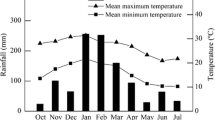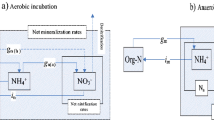Abstract
Nitrogen leaching persists in mountain forests of Europe even in the presence of decreasing N depositions. We have hypothesized that this leaching is linked to soil N transformations occurring over the whole year, even at 0°C temperatures. The aims were to estimate (1) the effect of temperature on N transformations and (2) N pools and fluxes. The study sites are situated in the Bohemian Forest (Czech Republic). Litter, humus, and 0–10-cm mineral layers were sampled in early spring, and the effect of temperature on net nitrification, net ammonification, and microbial N immobilization were measured in a short-term incubation experiment without substrate addition. Nitrogen pools were calculated from the concentrations of N forms in the soil and soil pool weights, while daily N fluxes were calculated from daily net rates of processes and soil pool weights. Relationships between temperature and net nitrification, net ammonification, and microbial N immobilization did not follow the Arrhenius type equation; all processes were active close to 0°C, indicating that microbial N transformations occur over the whole year. Microbial N immobilization rate was generally greater than N mineralization rate. The microbial N pool was significantly larger than mineral N pools. Organic layers containing tens of grams of available N per square meter contributed more than 70% to the available N in the soil profile. Daily N fluxes were related to N pools. On average, N fluxes represented daily mineral and microbial N pool changes of 1.14 and 1.95%, respectively. The effect of microbial composition on the C/N ratio of microbial biomass and respiration is discussed.




Similar content being viewed by others
References
Aber JD, Melillo JM, McClaugherty CA, Eshleman KN (1983) Nitrogen cycling in deciduous forests. Ecol Bull Stockh 33:427–442
Aber J, McDowell W, Nadelhoffer K, Magill A, Berntson G, Kamakea M, McNulty S, Currie W, Rustad L, Fernandez I (1998) Nitrogen saturation in temperate forest ecosystems. Bioscience 48:921–934 doi:10.2307/1313296
Anderson TH, Domsch KH (1986) Carbon assimilation and microbial activity in soil. Z Pflanzenernahr Bodenkd 149:457–468 doi:10.1002/jpln.19861490409
Binkley D, Hart SC (1989) The components of nitrogen availability assessments in forest soils. Adv Soil Sci 10:57–112
Binkley D, Stottlemyer R, Suarez F, Cortina J (1994) Soil nitrogen availability in some arctic ecosystems in northwest Alaska: Responses to temperature and moisture. Ecoscience 1:64–70
Bradley RL (2001) An alternative explanation for the post-disturbance NO3- flush in some forest ecosystems. Ecol Lett 4:412–416 doi:10.1046/j.1461-0248.2001.00243.x
Cabrera ML, Beare MH (1993) Alkaline persulfate oxidation for determining total nitrogen in microbial biomass extracts. Soil Sci Soc Am J 57:1007–1012
Carter MR (1991) Ninhydrin—reactive N released by the fumigation–extraction method as a measure of microbial biomass under field conditions. Soil Biol Biochem 23:139–143 doi:10.1016/0038-0717(91)90126-5
Chapman SJ, Gray TRG (1981) Endogenous metabolism and macromolecular-composition of arthrobacter-globiformis. Soil Biol Biochem 13:11–18 doi:10.1016/0038-0717(81)90095-X
Chapman SJ, Gray TRG (1986) Importance of cryptic growth, yield factors and maintenance energy in models of microbial growth in soil. Soil Biol Biochem 18:1–4 doi:10.1016/0038-0717(86)90095-7
Corre MD, Beese FO, Brumme R (2003) Soil nitrogen cycle in high nitrogen deposition forest: Changes under nitrogen saturation and liming. Ecol Appl 13:287–298 doi:10.1890/1051-0761(2003)013[0287:SNCIHN]2.0.CO;2
Davidson EA, Hart SC, Firestone MK (1992) Internal cycling of nitrate in soils of a mature coniferous forest. Ecology 73:1148–1156 doi:10.2307/1940665
Fernandez IJ, Simmons JA, Briggs RD (2000) Indices of forest floor nitrogen status along a climate gradient in Maine, USA. For Ecol Manage 134:177–187 doi:10.1016/S0378-1127(99)00256-X
Fitzhugh RD, Driscoll CT, Groffman PM, Tierney GL, Fahey TJ, Hardy JP (2001) Effects of soil freezing disturbance on soil solution nitrogen, phosphorus, and carbon chemistry in a northern hardwood ecosystem. Biogeochemistry 56:215–238 doi:10.1023/A:1013076609950
Groffman PM, Driscoll CT, Fahey TJ, Hardy JP, Fitzhugh RD, Tierney GL (2001) Effects of mild winter freezing on soil nitrogen and carbon dynamics in a northern hardwood forest. Biogeochemistry 56:191–213 doi:10.1023/A:1013024603959
Gundersen P, Schmidt IK, Raulund-Rasmussen K (2006) Leaching of nitrate from temperate forests—effects of air pollution and forest management. Environ Rev 14:1–57 doi:10.1139/a05-015
Högberg MN, Bååth E, Nordgren A, Arnebrant K, Högberg P (2003) Contrasting effects of nitrogen availability on plant carbon supply to mycorrhizal fungi and saprotrophs—a hypothesis based on field observations in boreal forest. New Phytol 160:225–238 doi:10.1046/j.1469-8137.2003.00867.x
Högberg MN, Chen Y, Högberg P (2007a) Gross nitrogen mineralisation and fungi-to-bacteria ratios are negatively correlated in boreal forests. Biol Fertil Soils 44:363–366 doi:10.1007/s00374-007-0215-9
Högberg MN, Högberg P, Myrold DD (2007b) Is microbial community composition in boreal forest soils determined by pH, C-to-N ratio, the trees, or all three? Oecologia 150:590–601 doi:10.1007/s00442-006-0562-5
Kennedy IR (1992) Acid soil and acid rain. Wiley, New York
Kettle H, Kopáček J, Hejzlar J (2003) Modelling air temperature at Čertovo Lake back to 1781. Silva Gabreta 9:15–32
Kopáček J, Hejzlar J (1998) Water chemistry of surface tributaries to the acidified mountain lakes in the Bohemian Forest. Silva Gabreta 2:175–197
Kopáček J, Veselý J, Stuchlík E (2001) Upshur and nitrogen fluxes and budgets in the Bohemian Forest and Tatra Mountains during the Industrial Revolution (1850–2000). Hydrol Earth Syst Sci 5:391–405
Kopáček J, Kaňa J, Šantrůčková H, Porcal P, Hejzlar J, Picek T, Šimek M, Veselý J (2002a) Physical, chemical, and biochemical characteristics of soils in watersheds of the Bohemian Forest lakes: II. Čertovo and Černé Lakes. Silva Gabreta 8:63–93
Kopáček J, Kaňa J, Šantrůčková H, Porcal P, Hejzlar J, Picek T, Veselý J (2002b) Physical, chemical, and biochemical characteristics of soils in watersheds of the Bohemian Forest lakes: I. Plešné Lake. Silva Gabreta 8:43–62
Kopáček J, Turek J, Hejzlar J, Kaňa J, Porcal P (2006a) Element fluxes in watershed-lake ecosystems recovering from acidification: Čertovo Lake, the Bohemian Forest, 2001–2005. Biologia (Bratisl) 61(Suppl 20):S413–S426 doi:10.2478/s11756-007-0066-8
Kopáček J, Turek J, Hejzlar J, Kaňa J, Porcal P (2006b) Element fluxes in watershed-lake ecosystems recovering from acidification: Plešné Lake, the Bohemian Forest, 2001–2005. Biologia (Bratisl) 61(Suppl 20):S427–S440 doi:10.2478/s11756-007-0067-7
Lawrence GB, David MB, Shortle WC (1995) A new mechanism for calcium loss in forest floor soils. Nature 378:162–165 doi:10.1038/378162a0
McGill WB, Cole CV (1981) Comparative aspects of cycling of organic C, N, S and P through soil organic-matter. Geoderma 26:267–286 doi:10.1016/0016-7061(81)90024-0
McNulty SG, Aber JD, Newman SD (1996) Nitrogen saturation in a high elevation New England spruce-fir stand. For Ecol Manage 84:109–121 doi:10.1016/0378-1127(96)03742-5
Melillo JM (1981) Nitrogen cycling in deciduous forest. Ecol Bull Stockh 33:427–442
Micks P, Aber JD, Boone RD, Davidson EA (2004) Short-term respiration and nitrogen immobilization response to nitrogen applications in control and nitrogen-enriched temperate forests. For Ecol Manage 196:57–70 doi:10.1016/j.foreco.2004.03.012
Mulder J, De Wit HA, Boonen HWJ, Bakken LR (2001) Increased levels of aluminium in forest soils: Effects on the stores of soil organic carbon. Water Air Soil Pollut 130:989–994 doi:10.1023/A:1013987607826
Nadelhoffer KJ, Giblin AE, Shaver GR, Laundre JA (1991) Effects of temperature and substrate quality on element mineralization in 6 artic soils. Ecology 72:242–253 doi:10.2307/1938918
Oulehle F, Hofmeister J, Cudlín P, Hruška J (2006) The effect of reduced atmospheric deposition on soil and soil solution chemistry at a site subjected to long-term acidification, Načetín, Czech Republic. Sci Total Environ 370:532–544 doi:10.1016/j.scitotenv.2006.07.031
Pirt SJ (1975) Principles of microbe and cell cultivation. Blackwell, Oxford
Puhe J, Ulrich B (2001) Global climate change and human impacts on forest ecosystems. Springer, Berlin
Rosswall T, Schnürer J, Söderlund S (1986) Interactions of acidity, aluminium ions and microorganisms. In: Jensen V, Kjøller A, Sørensen LH (eds) Microbial communities in soil. Elsevier, London, pp 395–403
Šantrůčková H, Vrba J, Picek T, Kopáček J (2004) Soil biochemical activity and P transformations and losses from acidified forest soils. Soil Biol Biochem 36:1569–1576 doi:10.1016/j.soilbio.2004.07.015
Scheel T, Doerfler C, Kalbitz K (2007) Precipitation of dissolved organic matter by aluminum stabilizes carbon in acidic forest soils. Soil Sci Soc Am J 71:64–74
Shaw A, Karlsson CH, Moller J (1988) An introduction to the use of flow injection analysis. Tecator, Sweden
Skopcová K, Šantrůčková H (2006) The effect of temperature on nitrogen transformations in mountain forest soils of Plešné, Černé, and Čertovo Lake watersheds. Silva Gabreta 12:3–14
Sprent JI (1987) The ecology of the nitrogen cycle. Cambridge University Press, Cambridge
Standing D, Baggs EM, Wattenbach M, Smith P, Killham K (2007) meeting the challenge of upscaling up peocesses in the plant–soil–microbe system. Biol Fertil Soils 44:245–257 doi:10.1007/s00374-007-0249-z
Stark JM, Hart SC (1997) High rates of nitrification and nitrate turnover in undisturbed coniferous forests. Nature 385:61–64 doi:10.1038/385061a0
Ste-Marie C, Paré D (1999) Soil, pH and N availability effects on net nitrification in the forest floors of a range of boreal forest stands. Soil Biol Biochem 31:1579–1589 doi:10.1016/S0038-0717(99)00086-3
Strader RH, Binkley D (1989) Mineralization and immobilization of soil nitrogen in two Douglas-fir stands 15 and 22 years after nitrogen fertilization. Can J Res 19:798–801 doi:10.1139/x89-121
Tietema A (1998) Microbial carbon and nitrogen dynamic in coniferous forest floor material collected along a European nitrogen deposition gradient. For Ecol Manage 101:29–36 doi:10.1016/S0378-1127(97)00122-9
Vance ED, Chapin FS III (2001) Substrate limitations to microbial activity in taiga forest floors. Soil Biol Biochem 33:173–188 doi:10.1016/S0038-0717(00)00127-9
Vitousek PM, Gosz JR, Grier CC, Melillo JM, Reiners WA (1982) A comparative analysis of potential nitrification and nitrate mobility in forest ecosystems. Ecol Monogr 52:155–177 doi:10.2307/1942609
Wallenstein MD, McNulty S, Fernandez IJ, Boggs J, Schlesinger WH (2006) Nitrogen fertilization decreases forest soil fungal and bacterial biomass in three long-term experiments. For Ecol Manage 222:459–468 doi:10.1016/j.foreco.2005.11.002
Zhong ZK, Makeschin F (2003) Soluble organic nitrogen in temperate forest soils. Soil Biol Biochem 35:333–338 doi:10.1016/S0038-0717(02)00252-3
Zhu WX, Carreiro MM (1999) Chemoautotrophic nitrification in acidic forest soils along an urban-to-rural transect. Soil Biol Biochem 31:1091–11 doi:10.1016/S0038-0717(99)00025-5
Acknowledgment
This study was supported by project GA CR 206/07/1200, MSM 6007665801, and project CZ 0051 (01-04/05-081 IP-65 MZP). We acknowledge the laboratory and field assistance provided by our colleagues and students, the contribution by Keith Edwards for language correction, and the contribution by the Editor-In-Chief for improving the style of the manuscript. We also thank the authorities of both NP and CHKO Šumava for the permission to carry out this study.
Author information
Authors and Affiliations
Corresponding author
Rights and permissions
About this article
Cite this article
Šantrůčková, H., Tahovská, K. & Kopáček, J. Nitrogen transformations and pools in N-saturated mountain spruce forest soils. Biol Fertil Soils 45, 395–404 (2009). https://doi.org/10.1007/s00374-008-0349-4
Received:
Revised:
Accepted:
Published:
Issue Date:
DOI: https://doi.org/10.1007/s00374-008-0349-4




